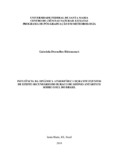| dc.creator | Bittencourt, Gabriela Dornelles | |
| dc.date.accessioned | 2018-12-27T11:36:26Z | |
| dc.date.available | 2018-12-27T11:36:26Z | |
| dc.date.issued | 2018-02-26 | |
| dc.identifier.uri | http://repositorio.ufsm.br/handle/1/15173 | |
| dc.description.abstract | The Antarctic Ozone Hole (AOH) is a cyclical phenomenon occurring during the austral
spring, where a temporary reduction in ozone content is observed in the Antarctic region.
However, ozone-depleted air masses can break away from the Ozone Hole and reach midlatitude
regions, known as the Secondary Effect of the Antarctic Ozone Hole. Thus, the
objective of this dissertation is to show how the stratospheric and tropospheric dynamics
behave during the occurrence of this type of event. For this purpose, daily data of the total
ozone column were used by the Brewer Spectrophotometer (MKIII # 167) and also OMI
satellite, to analyze the data and identify the events of influence of the BOA on the southern
region of Brazil. For the analysis of the stratospheric and tropospheric fields, reanalysis data
available by the ECMWF and stratospheric fields were used at four different isentropic levels
of potential temperature (475 Kelvin, 530 K, 600 K and 700 K). The tropospheric fields were:
i) sea level pressure and layer thickness between 1000 and 500 hPa; ii) horizontal cut of the
atmosphere (jet at 250 mb and Omega at 500 mb) and iii) vertical cut of the atmosphere
(between 1000 and 50 hPa of potential temperature). Thus, 34 events of influence of the
Antarctic Ozone Hole that reached the southern region of Brazil were identified for the period
of 11 years of data studied (2006 to 2016). Most events (~ 38%) were identified in the month
of October, and in September (~ 32.3%) was the second month when most events of the BOA
side effect were identified in the region. August and November are the months with the least
occurrence of events. In addition, the events showed a predominance of occurrence after the
passage of frontal systems (~ 68% of the cases) over the southern region of Brazil, and with
the presence of jet stream (polar or subtropical, ~ 91% of cases). | eng |
| dc.description.sponsorship | Coordenação de Aperfeiçoamento de Pessoal de Nível Superior - CAPES | por |
| dc.language | por | por |
| dc.publisher | Universidade Federal de Santa Maria | por |
| dc.rights | Attribution-NonCommercial-NoDerivatives 4.0 International | * |
| dc.rights.uri | http://creativecommons.org/licenses/by-nc-nd/4.0/ | * |
| dc.subject | Ozônio | por |
| dc.subject | Buraco de ozônio antártico | por |
| dc.subject | Dinâmica estratosférica e troposférica | por |
| dc.subject | Ozone | eng |
| dc.subject | Antarctic ozone hole | eng |
| dc.subject | Stratospheric and tropospheric dynamics | eng |
| dc.title | Influência da dinâmica atmosférica durante eventos de Efeito Secundário do Buraco de Ozônio Antártico sobre o Sul do Brasil | por |
| dc.title.alternative | Influence of atmospheric dynamic during events of the Secondary Effect of the Antarctic Ozone Hole over south of Brazil | eng |
| dc.type | Dissertação | por |
| dc.description.resumo | O Buraco de Ozônio Antártico (BOA) é um fenômeno cíclico que ocorre durante a primavera
austral, onde é observada uma redução temporária no conteúdo de ozônio na região Antártica.
No entanto, massas de ar pobre em ozônio podem se desprender do Buraco de Ozônio e
atingir regiões de médias latitudes, conhecido como Efeito Secundário do Buraco de Ozônio
Antártico. Dessa forma, o objetivo desta dissertação é mostrar como a dinâmica estratosférica
e troposférica se comporta durante a ocorrência deste tipo de evento. Para isso foram
utilizados dados médios diários da coluna total de ozônio pelo Espectrofotômetro Brewer
(MKIII #167) e também satélite OMI, para a análise dos dados e identificação dos eventos de
influência do BOA sobre a região Sul do Brasil. Para a análise dos campos estratosféricos e
troposféricos foram utilizados dados de reanálise disponíveis pelo ECMWF, e confeccionados
campos estratosféricos, em quatro diferentes níveis isentrópicos de temperatura potencial (475
Kelvin, 530 K, 600 K e 700 K). Já os campos troposféricos confeccionados foram: i) pressão
a nível médio do mar e espessura da camada entre 1000 e 500 hPa; ii) corte horizontal da
atmosfera (jato em 250 mb e Omega em 500 mb) e iii) corte vertical da atmosfera (entre 1000
e 50 hPa de temperatura potencial). Com isso, foram identificados 34 eventos de influência do
BOA que atingiram a região Sul do Brasil para o período de 11 anos de dados estudados
(2006 a 2016). A maioria dos eventos (~38 %) foi identificada no mês de outubro, já setembro
(~32,3 %) foi o segundo mês quando mais se identificaram eventos de efeito secundário do
BOA sobre a região. Agosto e Novembro são os meses com menor frequência de ocorrência
de eventos. Além disso, os eventos mostraram um predomínio de ocorrência após a passagem
de sistemas frontais (~68 % dos casos) sobre a região Sul do Brasil, e com a presença da
corrente de jato (polar ou subtropical; ~91 % dos casos). | por |
| dc.contributor.advisor1 | Pinheiro, Damaris Kirsch | |
| dc.contributor.advisor1Lattes | http://lattes.cnpq.br/9528588455662843 | por |
| dc.contributor.referee1 | Boiaski, Nathalie Tissot | |
| dc.contributor.referee1Lattes | http://lattes.cnpq.br/8599135403486788 | por |
| dc.contributor.referee2 | Peres, Lucas Vaz | |
| dc.contributor.referee2Lattes | http://lattes.cnpq.br/0492582888795669 | por |
| dc.creator.Lattes | http://lattes.cnpq.br/0046660896921944 | por |
| dc.publisher.country | Brasil | por |
| dc.publisher.department | Meteorologia | por |
| dc.publisher.initials | UFSM | por |
| dc.publisher.program | Programa de Pós-Graduação em Meteorologia | por |
| dc.subject.cnpq | CNPQ::CIENCIAS EXATAS E DA TERRA::GEOCIENCIAS::METEOROLOGIA | por |
| dc.publisher.unidade | Centro de Ciências Naturais e Exatas | por |



